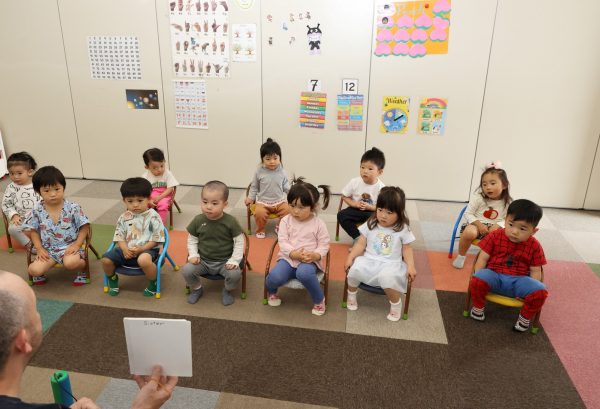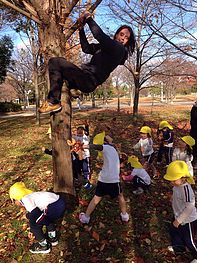
人間の脳細胞は生まれた時をピークに年々減少していきます。
中でも一生涯のうち、0歳から3歳までの幼少期の発育は、4歳から17歳までの少年期のそれに匹敵するとも上回るとも言われ、この時期の幼児の脳に刺激を与えないと非常に大きな損失になります。そこで…
There is a saying that from infancy, your surroundings and memory of those surroundings have a major effect on you once you reach adulthood. Human braincells are such that when you are born you’re at your peak for potential learning; with each year that passes after that, your abilities for new learning only decline. Above all, during one’s lifetime the years of infancy between 0 and 3 are the most important years for stimulating the human brain with new knowledge. From the age of 4 through 17, the brain is still equipped to learn effectively, but the absence of that potential stimuli in the years of infancy creates an enormous loss.
『15分刻みのカリキュラム』で効率よく脳に刺激を
A 15 minute brain-chiseling curriculum with highly effective brain stimulation

レインボーでは15分刻みに組まれたカリキュラムを用意しております。
芸術・音楽・理科・社会・算数をはじめ・ひらがな・カタカナ・漢字・ドッツカード・絵カード・時計カード・元素カード等あらゆるカード用いてリズミカルに行われます。
同スクールでは、部分から全体を読めるようになるフォニックスに加え、右脳・左脳訓練による全体から丸ごと覚えていくホールランゲージを導入し、バランスを考えた充実した授業を行います。
At Rainbow, we use a 15-minute brain-chiseling curriculum that has been put together by experts in the field. Through the use of flashcards in a rhythmic way, subjects like art, music, science, social studies and mathematics are introduced, in addition to the study of Japanese hiragana, katakana and the writing of kanji characters. Also at our school, children gain the ability to understand English phonics from simple letters to more complex sentences. Through both right and left brain-focused drills, a fully-engaged approach to remembering subject items as well as a balanced method of introducing new material are utilized with great results.
実はとても重要な6歳までの過ごし方
Understanding human growth before 6 years of age
図1は、人間の年齢と脳内のシナプスの推移を表しています。
この図から人間の脳内にあるシプナス(神経細胞の接点)は、6歳をピークに減少していくことがおわかりでしょう。
このグラフは如実に6歳までに使用しないシプナスは淘汰されていく事を表しています。 シプナスが低下・減少し始めてからでは新しく物事を習得するには大変 な努力を要し、大人になってから英語をマスターするのが難しいのは、こういう理由があったのです。
重要なことは、シプナスが増えている6歳ぐらいまでの期間こそ、きちんとした教育と環境を用意しないと減少してからでは遅いということです。
よく左脳は言語・記憶・論理の脳、右脳は感性・ひらめき・直感・イメージの脳といわれています。
何ごともいったん言語による思考・理解を当して記憶や情報 処理がなされ、意識的な使用で機能するのが左脳です。
一方、右脳が機能する時は、潜在意識=無意識で力を発揮し、ひらめき・直感・想像力や創造力といった 優れて感性的な能力が引き出されるのです。
言語思考を介する左脳の記憶・情報処理はどうしても遅くなりますが、右脳には潜在意識の働きにより、物事をイ メージによって理解することで、瞬時に大量の情報を記憶し、また高速で処理してしまうという、優れた機能があります。潜在意識を目覚めさせ、右脳を活発に働かせる-これが能力開発の鍵です。
This graph shows the synapse changes in the human brain relative to age (shown on the bottom axis). It’s clear here that brain synapses peak at age 6 and steadily decline from then on. This graph illustrates as well the synapses not used before the age of 6 that are naturally weeded out. At the decline of synapse production, the ability to take in and effectively retain new knowledge is only possible with the utmost persistence and it is for this reason that when we become adults, things like mastering English, for example, become very difficult. The most important thing to remember here is that as brain synapses increase to their highest peak between 0 and 6, if a clearly focused education and a stimulating environment for the child is not provided, it may already be too late for significant strides after the age of 6.





